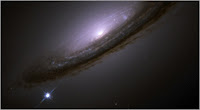From the Clash of White Dwarfs, the Birth of a Supernova
 How many ways can a star go “kaboom!”? It might depend on what kind of galaxy the star lives in, astronomers said last week.
How many ways can a star go “kaboom!”? It might depend on what kind of galaxy the star lives in, astronomers said last week.
For the last 20 years, astronomers seeking to measure the cosmos have used a special type of exploding star, known as Type 1a supernovas, as distance markers. They are thought to result when stars known as white dwarfs grow beyond a certain weight limit, setting off a thermonuclear cataclysm that is not only bright enough to be seen across the universe but is also remarkably uniform from one supernova to the next. Using them, two teams of astronomers a little more than a decade ago reached the startling and now widely held conclusion that some “dark energy” was speeding up the expansion of the universe.
But astronomers, to their embarrassment, have not been able to agree on how the white dwarf gains its fatal weight and explodes, whether by slowly grabbing material from a neighboring star or by crashing into another white dwarf.
In a telephone news conference on Wednesday and a paper published Thursday in the journal Nature, Marat Gilfanov and his colleague, Akos Bogdan, both of the Max Planck Institute for Astrophysics in Garching, Germany, said that for at least one class of galaxies in the universe, the roundish conglomerations of older, redder stars known as ellipticals, these supernovas are mostly produced by collisions.
“We have revealed the source of the most important explosions in cosmology,” Dr. Gilfanov said, adding that until now “we didn’t know exactly what they were.”
Reasoning that white dwarfs slowly gobbling gas from neighbors would emit X-rays as the captured gas fell and was heated, Dr. Gilfanov and Dr. Bogdan used NASA’s Chandra X-Ray Observatory to look at five elliptical galaxies and the central bulge of the nearby Andromeda galaxy — all of which are composed of older stars. The satellite recorded only about one-thirtieth to one-fiftieth of the X-rays that would be expected from such white dwarfs, leading the astronomers to conclude that no more than 5 percent of the supernovas in those types of stellar systems could be produced by accreting white dwarfs.
The observations leave open the possibility that accreting dwarfs might be responsible for more of the supernovas in spiral galaxies like our own, which tend to have younger, more massive stars.
That leaves open the possibility of two different kinds of Type 1a supernovas at loose in the universe and could add extra uncertainty into efforts to use exploding stars as standard candles to make precise measurements of the universe. Accreting white dwarfs go off at a precisely determined mass known as the Chandrasekhar limit, but a pair of colliding dwarfs could have a range of masses.
Mario Livio, a theorist at the Space Telescope Science Institute, said that while the new results and the idea of two classes of supernovas “muddies the water,” they would not affect the measurements of dark energy. Most of the supernovas in those studies, he said, came from spiral galaxies, and the astronomers, moreover, were very careful to calibrate their data.
“The main results so far will remain unchanged,” Dr. Livio said.
Adam Riess, of Johns Hopkins University and the Space Telescope Science Institute and a first-rate dark energy hunter, called the new paper “an interesting study.” He compared the two theories of supernovas to lighting a stick of dynamite with a fuse versus banging them together to see if they would go off. “If we find a connection to where nature does it one way versus the other, we could use that information to improve the use of these candles,” Dr. Riess wrote in an e-mail message. “I think we are getting close to that point now.”
No Response to "From the Clash of White Dwarfs, the Birth of a Supernova"
Post a Comment